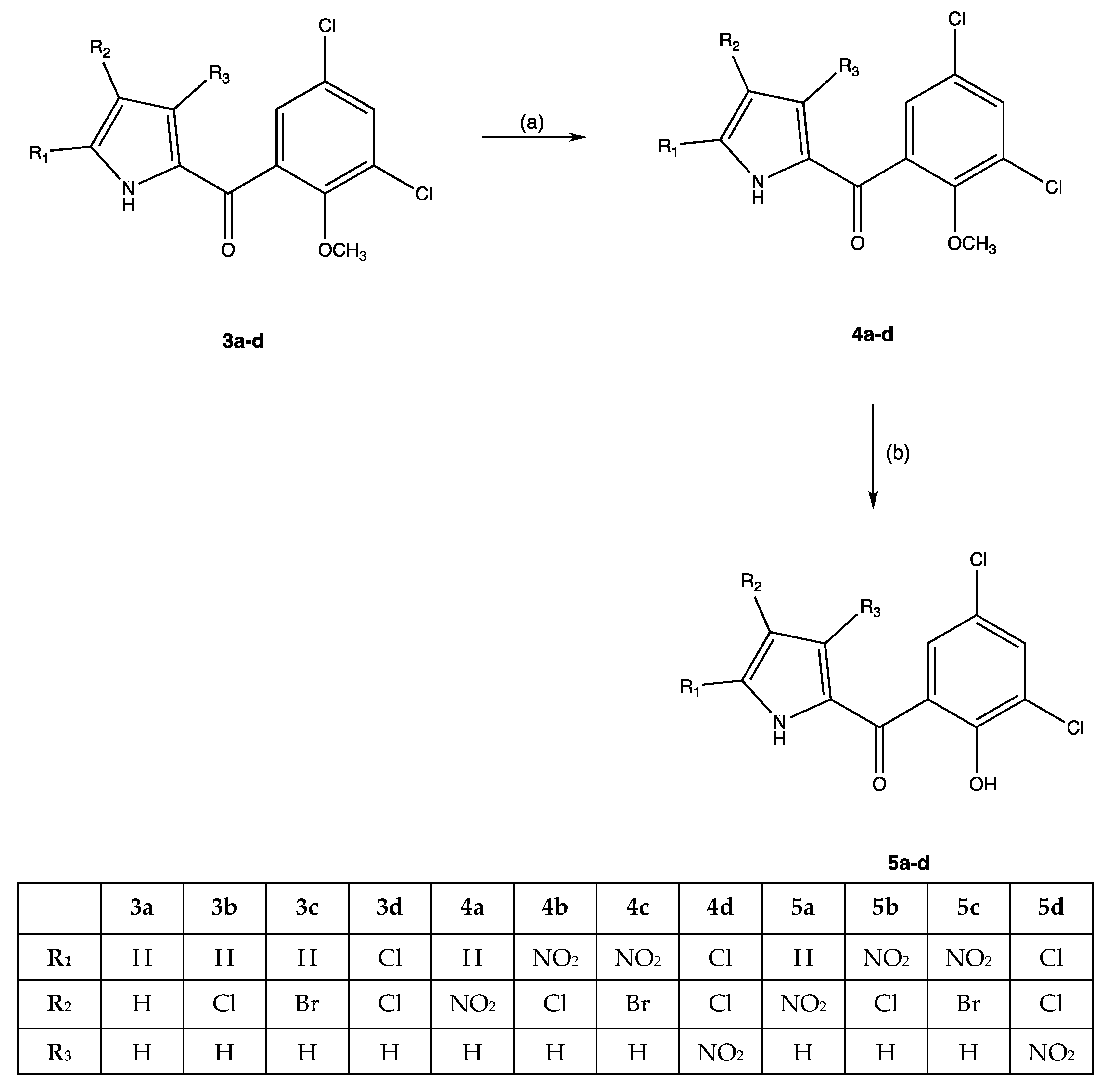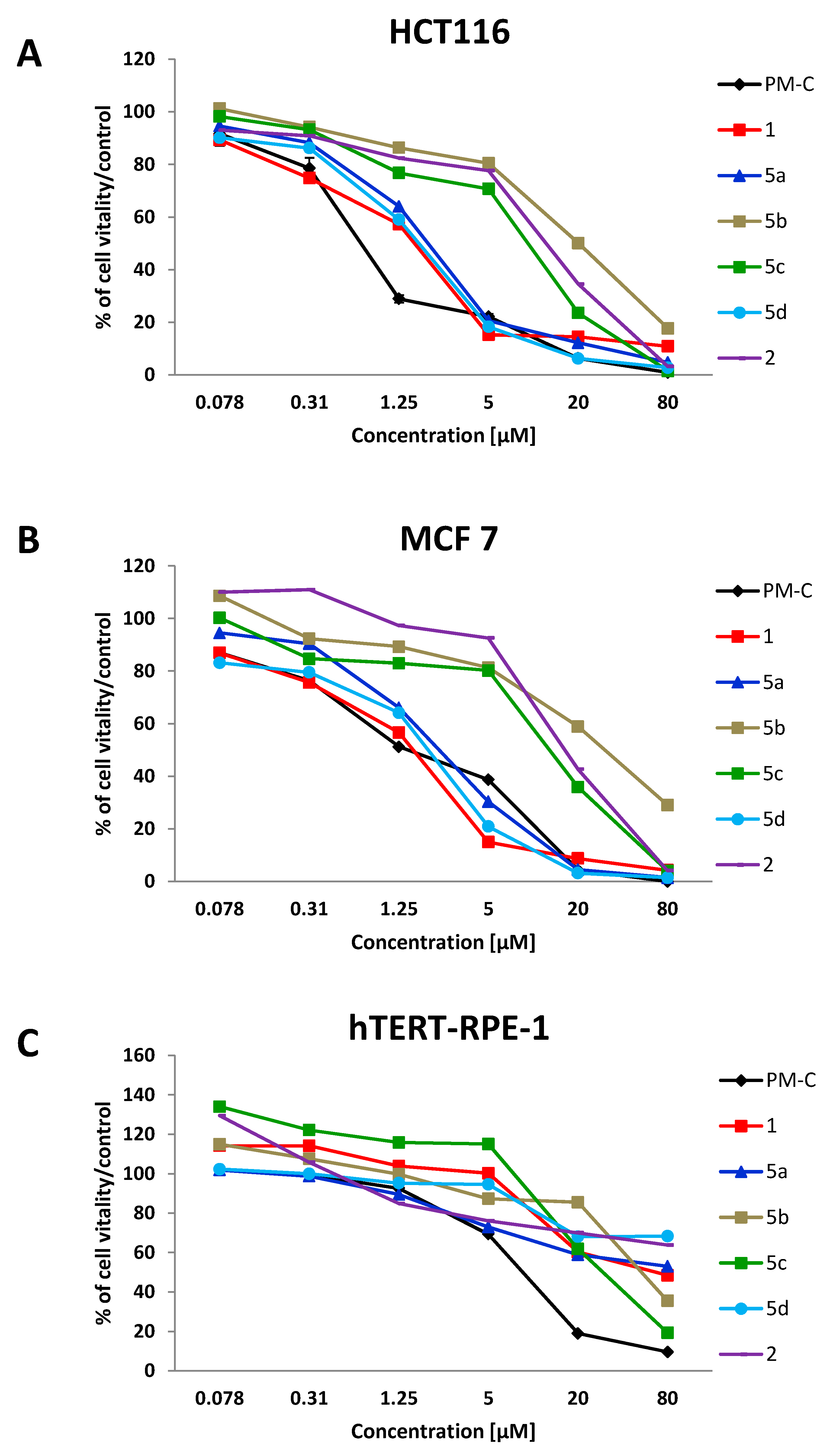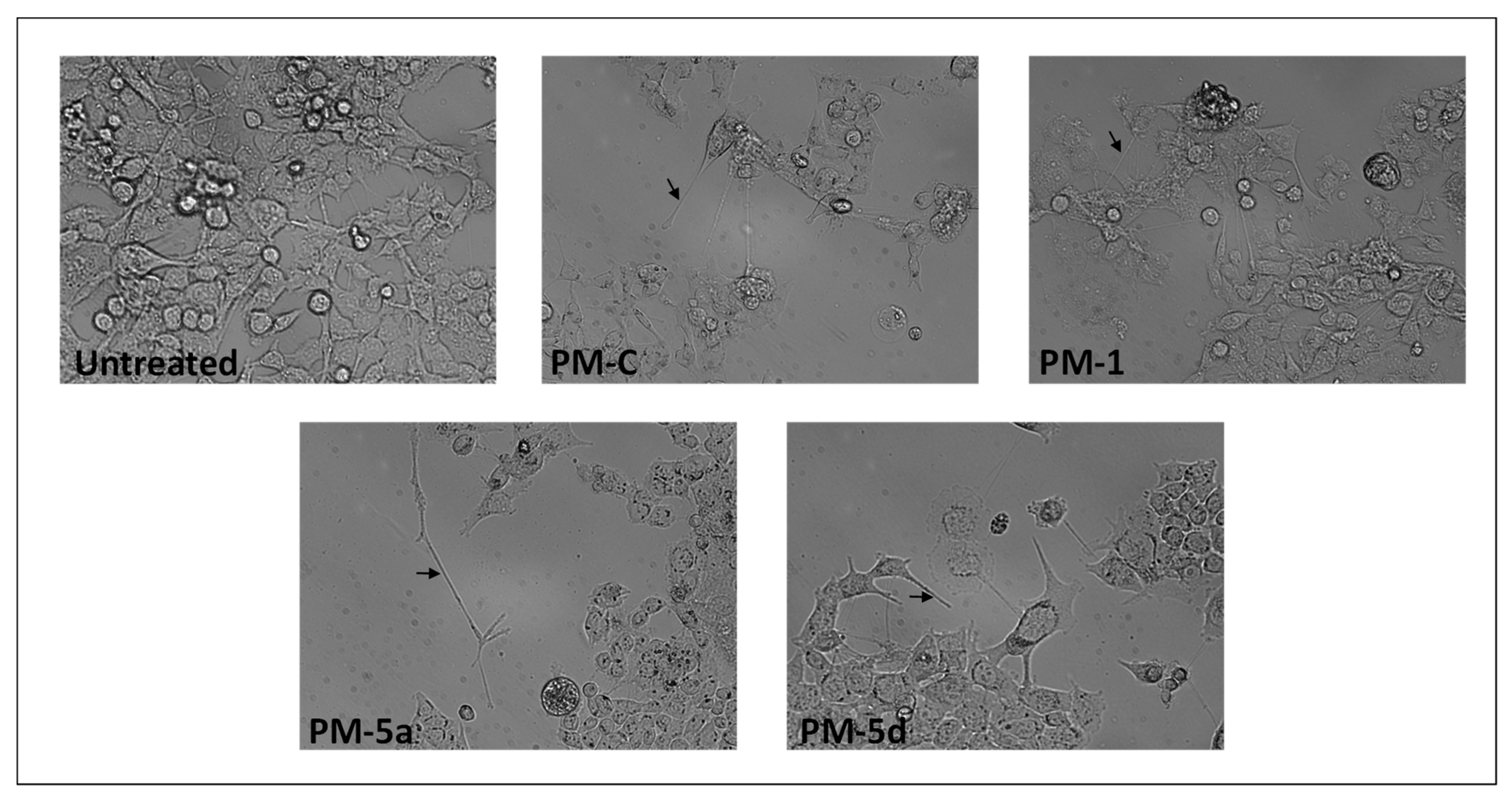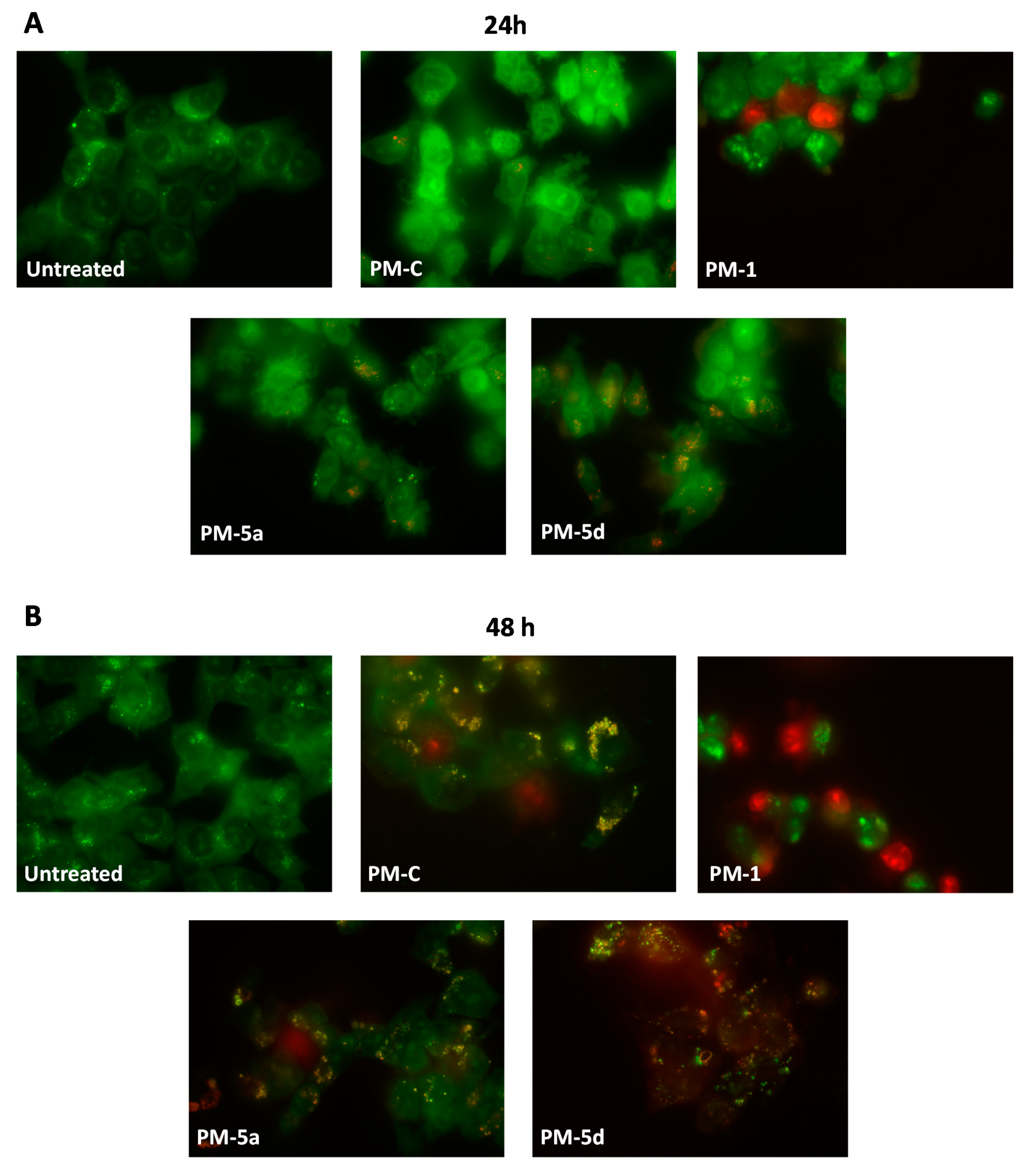New Synthetic Nitro-Pyrrolomycins as Promising Antibacterial and Anticancer Agents
Abstract
:1. Introduction
2. Results and Discussion
2.1. Synthesis of new Pyrrolomycins
2.2. Antimicrobial Efficacy of New Pyrrolomycins
2.3. Antitumoral and Cytotoxic Effects of new Pyrrolomycins
2.4. In silico ADMET (Absorption, Distribution, Metabolism, Elimination and Toxicity) Profile of New Pyrrolomycins
3. Conclusions
4. Experimental Section
4.1. Chemistry
4.1.1. Materials and Instruments
4.1.2. Methods
(3,5-Dichloro-2-methoxyphenyl)(4-nitro-1H-pyrrol-2-yl)methanone (4a)
(4-Chloro-5-nitro-1H-pyrrol-2-yl)(3,5-dichloro-2-methoxyphenyl)methanone (4b)
(4-Bromo-5-nitro-1H-pyrrol-2-yl)(3,5-dichloro-2-methoxyphenyl)methanone (4c)
(3,5-Dichloro-2-methoxyphenyl)(4,5-dichloro-3-nitro-1H-pyrrol-2-yl)methanone (4d)
General Procedure for Preparation of Pyrrolomycins 5a–d
(3,5-Dichloro-2-hydroxyphenyl)(4-nitro-1H-pyrrol-2-yl)methanone (5a)
(4-Chloro-5-nitro-1H-pyrrol-2-yl)(3,5-dichloro-2-hydroxyphenyl)methanone (5b)
(4-Bromo-5-nitro-1H-pyrrol-2-yl)(3,5-dichloro-2-hydroxyphenyl)methanone (5c)
(3,5-Dichloro-2-hydroxyphenyl)(4,5-dichloro-3-nitro-1H-pyrrol-2-yl)methanone (5d)
Synthesis of the (3,5-Dibromo-2-methoxyphenyl)(3,4,5-tribromo-1-methyl-1H-pyrrol-2-yl)methanone (2)
(3,5-Dibromo-2-methoxyphenyl)(3,4,5-tribromo-1-methyl-1H-pyrrol-2-yl)methanone (2)
4.1.3. In silico ADMET (Absorption, Distribution, Metabolism, Excretion and Toxicity) Calculation
4.2. Biology
4.2.1. Biocidal and Inhibitory Activity of New Pyrrolomycins
4.2.2. Cell Cultures and Treatments
4.2.3. MTT Viability Assay
4.2.4. Morphological Assessment and Acridine Orange/Ethidium Bromide (AO/EB) Staining
Supplementary Materials
Author Contributions
Funding
Acknowledgments
Conflicts of Interest
References
- Carter, G.T.; Nietsche, J.A.; Goodman, J.J.; Torrey, M.J.; Dunne, T.S.; Borders, D.B.; Testa, R.T. LL-F42248α, a novel chlorinated pyrrole antibiotic. J. Antibiot. 1987, 40, 233–236. [Google Scholar] [CrossRef] [PubMed] [Green Version]
- Koyama, M.; Ezaki, N.; Tsuruoka, T.; Inouye, S. Structural studies on pyrrolomycins C, D and E. J. Antibiot. 1983, 36, 1483–1489. [Google Scholar] [CrossRef] [PubMed]
- Schillaci, D.; Petruso, S.; Sciortino, V. 3,4,5,3′,5′-Pentabromo-2-(2′-hydroxybenzoyl)pyrrole: A potential lead compound as anti-Gram-positive and anti-biofilm agent. Int. J. Antimicrob. Agents 2005, 25, 338–340. [Google Scholar] [CrossRef] [PubMed] [Green Version]
- Cascioferro, S.; Raimondi, M.V.; Cusimano, M.G.; Raffa, D.; Maggio, B.; Daidone, G.; Schillaci, D. Pharmaceutical potential of synthetic and natural pyrrolomycins. Molecules 2015, 20, 21658–21671. [Google Scholar] [CrossRef] [Green Version]
- Schillaci, D.; Petruso, S.; Raimondi, M.V.; Cusimano, M.G.; Cascioferro, S.; Scalisi, M.; La Giglia, M.A.; Vitale, M. Pyrrolomycins as potential anti-staphylococcal biofilms agents. Biofouling 2010, 26, 433–438. [Google Scholar] [CrossRef] [Green Version]
- Raimondi, M.V.; Cascioferro, S.; Schillaci, D.; Petruso, S. Synthesis and antimicrobial activity of new bromine-rich pyrrole derivatives related to monodeoxypyoluteorin. Eur. J. Med. Chem. 2006, 41, 1439–1445. [Google Scholar] [CrossRef]
- Schillaci, D.; Petruso, S.; Cascioferro, S.; Raimondi, M.V.; Haagensen, J.A.J.; Molin, S. In vitro anti-Gram-positive and antistaphylococcal biofilm activity of newly halogenated pyrroles related to pyrrolomycins. Int. J. Antimicrob. Agents 2008, 31, 380–382. [Google Scholar] [CrossRef]
- Raimondi, M.V.; Schillaci, D.; Petruso, S. Synthesis and anti-staphylococcal activity of new halogenated pyrroles related to Pyrrolomycins F. J. Heterocycl. Chem. 2007, 44, 1407–1411. [Google Scholar] [CrossRef]
- Raimondi, M.V.; Listro, R.; Cusimano, M.G.; La Franca, M.; Faddetta, T.; Gallo, G.; Schillaci, D.; Collina, S.; Leonchiks, A.; Barone, G. Pyrrolomycins as antimicrobial agents. Microwave-assisted organic synthesis and insights into their antimicrobial mechanism of action. Bioorg. Med. Chem. 2019, 27, 721–728. [Google Scholar] [CrossRef]
- Yang, Z.; Liu, Y.; Ahn, J.; Qiao, Z.; Endres, J.L.; Gautam, N.; Huang, Y.; Li, J.; Zheng, J.; Alnouti, Y.; et al. Novel fluorinated pyrrolomycins as potent anti-staphylococcal biofilm agents: Design, synthesis, pharmacokinetics and antibacterial activities. Eur. J. Med. Chem. 2016, 124, 129–137. [Google Scholar] [CrossRef]
- Valderrama, K.; Pradel, E.; Firsov, A.M.; Drobecq, H.; Bauderlique-le Roy, H.; Villemagne, B.; Antonenko, Y.N.; Hartkoorn, R.C. Pyrrolomycins are potent natural protonophores. Antimicrob. Agents Chemother. 2019, 63. [Google Scholar] [CrossRef] [PubMed]
- Conder, G.A.; Zielinski, R.J.; Johnson, S.S.; Kuo, M.-S.T.; Cox, D.L.; Marshall, V.P.; Haber, C.L.; Diroma, P.J.; Nelson, S.J.; Conklin, R.D.; et al. Anthelmintic activity of dioxapyrrolomycin. J. Antibiot. 1992, 45, 977–983. [Google Scholar] [CrossRef] [PubMed] [Green Version]
- Masuda, K.; Suzuki, K.; Ishida-Okawara, A.; Mizuno, S.; Hotta, K.; Miyadoh, S.; Hara, O.; Kojama, M. Pyrrolomycin group antibiotics inhibit substance P-induced release of myeloperoxidase from human polymorphonuclear leukocytes. J. Antibiot. (Tokyo) 1991, 44, 533–540. [Google Scholar] [CrossRef] [PubMed] [Green Version]
- Umezawa, K.; Ishizuka, M.; Sawa, T.; Takeuchi, T. Enhancement of mouse immune system by pyrrolomycin B. J. Antibiot. 1984, 37, 1253–1256. [Google Scholar] [CrossRef]
- Ma, Q.; Liu, Y.; Zhang, P.; Li, Y.; Xiong, L.; Wang, Q. Design, synthesis, and biological evaluation of various α-substituted benzylpyrroles based on the structures of insecticidal chlorfenapyr and natural pyrrolomycins. J. Agric. Food Chem. 2014, 62, 6072–6081. [Google Scholar] [CrossRef]
- Li, R. Marinopyrroles: Unique drug discoveries based on marine natural products. Med. Res. Rev. 2016, 36, 169–189. [Google Scholar] [CrossRef]
- Cheng, C.; Pan, L.; Chen, Y.; Song, H.; Qin, Y.; Li, R. Total synthesis of (+/-)-marinopyrrole A and its library as potential antibiotic and anticancer agents. J. Comb. Chem. 2010, 12, 541–547. [Google Scholar] [CrossRef]
- McGuire, T.R.; Coulter, D.W.; Bai, D.; Sughroue, J.A.; Li, J.; Yang, Z.; Qiao, Z.; Liu, Y.; Murry, D.J.; Chhonker, Y.S.; et al. Effects of novel pyrrolomycin MP1 in MYCN amplified chemoresistant neuroblastoma cell lines alone and combined with temsirolimus. BMC Cancer 2019, 19, 837. [Google Scholar] [CrossRef] [Green Version]
- Zhang, X.; Parry, R.J. Cloning and characterization of the pyrrolomycin biosynthetic gene clusters from Actinosporangium vitaminophilum ATCC 31673 and Streptomyces sp. Strain UC 11065. Antimicrob. Agents Chemother. 2007, 51, 946–957. [Google Scholar] [CrossRef] [Green Version]
- Maggio, B.; Raffa, D.; Raimondi, M.V.; Cascioferro, S.; Plescia, F.; Schillaci, D.; Cusimano, M.G.; Leonchiks, A.; Zhulenkovs, D.; Basile, L.; et al. Discovery of a new class of sortase A transpeptidase inhibitors to tackle Gram-positive pathogens: 2-(2-Phenylhydrazinylidene)alkanoic acids and related derivatives. Molecules 2016, 21, 241. [Google Scholar] [CrossRef] [Green Version]
- Cascioferro, S.; Maggio, B.; Raffa, D.; Raimondi, M.V.; Cusimano, M.G.; Schillaci, D.; Manachini, B.; Plescia, F.; Daidone, G. Synthesis and biofilm formation reduction of pyrazole-4-carboxamide derivatives in some Staphylococcus aureus strains. Eur. J. Med. Chem. 2016, 123, 58–68. [Google Scholar] [CrossRef] [PubMed]
- Presentato, A.; Lampis, S.; Vantini, A.; Manea, F.; Daprà, F.; Zuccoli, S.; Vallini, G. On the ability of Perfluorohexane Sulfonate (PFHxS) bioaccumulation by two Pseudomonas sp. strains isolated from PFAS-contaminated environmental matrices. Microorganisms 2020, 8, 92. [Google Scholar] [CrossRef] [PubMed] [Green Version]
- Presentato, A.; Cappelletti, M.; Sansone, A.; Ferreri, C.; Piacenza, E.; Demeter, M.A.; Crognale, S.; Petruccioli, M.; Milazzo, G.; Fedi, S.; et al. Aerobic growth of Rhodococcus aetherivorans BCP1 using selected naphthenic acids as the sole carbon and energy sources. Front. Microbiol. 2018, 9. [Google Scholar] [CrossRef] [PubMed]
- Frank, R.A.; Kavanagh, R.; Kent Burnison, B.; Arsenault, G.; Headley, J.V.; Peru, K.M.; van Der Kraak, G.; Solomon, K.R. Toxicity assessment of collected fractions from an extracted naphthenic acid mixture. Chemosphere 2008, 72, 1309–1314. [Google Scholar] [CrossRef]
- Murínová, S.; Dercová, K. Response mechanisms of bacterial degraders to environmental contaminants on the level of cell walls and cytoplasmic membrane. Int. J. Microbiol. 2014, 2014, 873081. [Google Scholar] [CrossRef] [Green Version]
- Sikkema, J.; de Bont, J.A.; Poolman, B. Mechanisms of membrane toxicity of hydrocarbons. Microbiol. Mol. Biol. Rev. 1995, 59, 201–222. [Google Scholar] [CrossRef]
- Cancemi, P.; Buttacavoli, M.; D’Anna, F.; Feo, S.; Fontana, R.M.; Noto, R.; Sutera, A.; Vitale, P.; Gallo, G. The effects of structural changes on the anti-microbial and anti-proliferative activities of diimidazolium salts. New J. Chem. 2017, 41, 3574–3585. [Google Scholar] [CrossRef]
- Hughes, C.G.; Rees, A.H. Nitro analogs of pyoluteorins. J. Med. Chem. 1973, 16, 574–576. [Google Scholar] [CrossRef]
- Charan, R.D.; Schlingmann, G.; Bernan, V.S.; Feng, X.; Carter, G.T. Additional pyrrolomycins from cultures of Streptomyces fumanus. J. Nat. Prod. 2005, 68, 277–279. [Google Scholar] [CrossRef]
- Braun, M.; Silhavy, T.J. Imp/OstA is required for cell envelope biogenesis in Escherichia coli. Mol. Microbiol. 2002, 45, 1289–1302. [Google Scholar] [CrossRef] [Green Version]
- Poma, P.; Labbozzetta, M.; Zito, P.; Alduina, R.; Ramarosandratana, A.V.; Bruno, M.; Rosselli, S.; Sajeva, M.; Notarbartolo, M. Essential oil composition of alluaudia procera and in vitro biological activity on two drug-resistant models. Molecules 2019, 24, 2871. [Google Scholar] [CrossRef] [PubMed] [Green Version]
- Ciabocco, M.; Cancemi, P.; Saladino, M.L.; Caponetti, E.; Alduina, R.; Berrettoni, M. Synthesis and antibacterial activity of iron-hexacyanocobaltate nanoparticles. J. Biol. Inorg. Chem. 2018, 23, 385–398. [Google Scholar] [CrossRef] [PubMed]
- Rubino, S.; Pibiri, I.; Minacori, C.; Alduina, R.; Di Stefano, V.; Orecchio, S.; Buscemi, S.; Girasolo, M.A.; Tesoriere, L.; Attanzio, A. Synthesis, structural characterization, anti-proliferative and antimicrobial activity of binuclear and mononuclear Pt(II) complexes with perfluoroalkyl-heterocyclic ligands. Inorganica Chimica Acta 2018, 483, 180–190. [Google Scholar] [CrossRef]
- Saladino, M.L.; Markowska, M.; Carmone, C.; Cancemi, P.; Alduina, R.; Presentato, A.; Scaffaro, R.; Biały, D.; Hasiak, M.; Hreniak, D.; et al. Graphene oxide carboxymethylcellulose nanocomposite for dressing materials. Materials (Basel) 2020, 13, 1980. [Google Scholar] [CrossRef]
- Alduina, R. Antibiotics and environment. Antibiotics 2020, 9, 202. [Google Scholar] [CrossRef]
- Blasi, M.F.; Migliore, L.; Mattei, D.; Rotini, A.; Thaller, M.C.; Alduina, R. Antibiotic resistance of Gram-negative bacteria from wild captured loggerhead sea turtles. Antibiotics 2020, 9, 162. [Google Scholar] [CrossRef] [Green Version]
- Alduina, R.; Gambino, D.; Presentato, A.; Gentile, A.; Sucato, A.; Savoca, D.; Filippello, S.; Visconti, G.; Caracappa, G.; Vicari, D.; et al. Is Caretta caretta a carrier of antibiotic resistance in the Mediterranean Sea? Antibiotics 2020, 9, 116. [Google Scholar] [CrossRef] [Green Version]
- Nakkala, J.R.; Mata, R.; Gupta, A.K.; Sadras, S.R. Biological activities of green silver nanoparticles synthesized with Acorous calamus rhizome extract. Eur. J. Med. Chem. 2014, 85, 784–794. [Google Scholar] [CrossRef]
- Pires, D.E.V.; Blundell, T.L.; Ascher, D.B. pkCSM: Predicting small-molecule pharmacokinetic and toxicity properties using graph-based signatures. J. Med. Chem. 2015, 58, 4066–4072. [Google Scholar] [CrossRef]
- Piacenza, E.; Presentato, A.; Zonaro, E.; Lemire, J.A.; Demeter, M.; Vallini, G.; Turner, R.J.; Lampis, S. Antimicrobial activity of biogenically produced spherical Se-nanomaterials embedded in organic material against Pseudomonas aeruginosa and Staphylococcus aureus strains on hydroxyapatite-coated surfaces. Microb. Biotechnol. 2017, 10, 804–818. [Google Scholar] [CrossRef] [Green Version]
- Piacenza, E.; Presentato, A.; Ambrosi, E.; Speghini, A.; Turner, R.J.; Vallini, G.; Lampis, S. Physical-chemical properties of biogenic selenium nanostructures produced by Stenotrophomonas maltophilia SeITE02 and Ochrobactrum sp. MPV1. Front. Microbiol. 2018, 9, 3178. [Google Scholar] [CrossRef] [PubMed] [Green Version]
- Presentato, A.; Piacenza, E.; Darbandi, A.; Anikovskiy, M.; Cappelletti, M.; Zannoni, D.; Turner, R.J. Assembly, growth and conductive properties of tellurium nanorods produced by Rhodococcus aetherivorans BCP1. Sci. Rep. 2018, 8, 1–10. [Google Scholar] [CrossRef] [PubMed] [Green Version]
- Musso, R.; Di Cara, G.; Albanese, N.N.; Marabeti, M.R.; Cancemi, P.; Martini, D.; Orsini, E.; Giordano, C.; Pucci-Minafra, I. Differential proteomic and phenotypic behaviour of papillary and anaplastic thyroid cell lines. J. Proteomics 2013, 90, 115–125. [Google Scholar] [CrossRef] [PubMed]
- DI Cara, G.; Marengo, G.; Albanese, N.N.; Marabeti, M.R.; Musso, R.; Cancemi, P.; Pucci-Minafra, I. Proteomic profiling of Trastuzumab (Herceptin(R))-sensitive and -resistant SKBR-3 breast cancer cells. Anticancer Res. 2013, 33, 489–503. [Google Scholar]
- Cancemi, P.; Albanese, N.N.; DiCara, G.; Marabeti, M.R.; Costantini, F.; Minafra, S.; Pucci-Minafra, I. Multiple changes induced by fibroblasts on breast cancer cells. Connect. Tissue Res. 2010, 51, 88–104. [Google Scholar] [CrossRef] [Green Version]
- Pucci-Minafra, I.; Albanese, N.N.; Di Cara, G.; Minafra, L.; Marabeti, M.R.; Cancemi, P. Breast cancer cells exhibit selective modulation induced by different collagen substrates. Connect. Tissue Res. 2008, 49, 252–256. [Google Scholar] [CrossRef]








| PMs | MBC a P. aeruginosa | MBC a S. aureus | IC50 HCT116 b | IC50 MCF 7 b | IC50 hTERT-RPE-1 b | C-SI c | B-SI d |
|---|---|---|---|---|---|---|---|
| C | >100 | 90 | 0.8 ± 0.3 | 1.5 ± 0.4 | 8.3 ± 1.9 | 10.4–5.5 | >0.01–0.9 |
| 1 | >100 | 5 | 1.3 ± 0.3 | 1.2 ± 0.7 | 57.7 ± 11.2 | 44.2-47.3 | >0.6–11.5 |
| 2 | >100 | 70 | 11.1 ± 3.3 | 17.2 ± 3.2 | 149 ± 41 | 13.4-8.6 | >1.5–2.1 |
| 5a | >100 | 60 | 1.9 ± 0.42 | 2.2 ± 0.3 | 65.8 ± 10.5 | 34.6–29.2 | >0.7-1.1 |
| 5b | >100 | 20 | 18.7 ± 3.8 | 28.8 ±4.2 | 55.4 ± 13.2 | 3–1.9 | >0.6–2.8 |
| 5c | >100 | 1 | 7.6 ± 1.9 | 12.0± 2.8 | 29.7 ± 5.7 | 10.4–5.5 | >0.3–29.7 |
| 5d | 30 | 7.5 | 1.6 ± 0.2 | 1.6 ± 0.4 | 224.9 ± 22.7 | 143.3–143.4 | 7.5–30 |
| Heading | PM-C | 1 | 2 | 5a | 5b | 5c | 5d | Range 95% of Drugs |
|---|---|---|---|---|---|---|---|---|
| cLogPo/w | 4.476 | 4.889 | 5.637 | 2.496 | 3.200 | 3.132 | 3.746 | −2.0/6.5 |
| cLogS | −5.031 | −6.250 | −6.331 | −4.126 | −4.744 | −4.945 | −5.419 | −6.5/0.5 |
| cLogKhsa | 0.364 | 0.568 | 0.628 | 0.108 | 0.209 | 0.240 | 0.319 | −1.5/1.5 |
| cLogBB | 0.219 | 0.376 | 1.039 | −1.138 | −0.681 | −0.890 | −0.444 | −3.0/1.2 |
| CNS Activity | + | + | ++ | − − | +/− | − | +/− | − − (inactive) ++ (active) |
| cLogHERG | −4.511 | −4.436 | −4.259 | −4.586 | −4.583 | −4.627 | −4.515 | concern below −5 |
| cPCaco | 1298 | 1338 | 7162 | 131 | 277 | 175 | 344 | <25 poor >500 great |
| clogKp | −2.518 | −2.594 | −1.215 | −4.245 | −3.667 | −4.111 | −3.617 | Kp in cm/hr |
| Percent Human Oral Absorption ±20% | 100 | 100 | 100 | 79 | 89 | 85 | 94 | <25% poor |
| Jorgensen Rule | 0 | 1 | 1 | 0 | 0 | 0 | 0 | maximum 3 |
| Lipinski Rule | 0 | 1 | 2 | 0 | 0 | 0 | 0 | maximum 4 |
| # Stars (violation of the 95% range) | 2 | 2 | 2 | 0 | 1 | 1 | 1 | 0-5 |
© 2020 by the authors. Licensee MDPI, Basel, Switzerland. This article is an open access article distributed under the terms and conditions of the Creative Commons Attribution (CC BY) license (http://creativecommons.org/licenses/by/4.0/).
Share and Cite
Raimondi, M.V.; Presentato, A.; Li Petri, G.; Buttacavoli, M.; Ribaudo, A.; De Caro, V.; Alduina, R.; Cancemi, P. New Synthetic Nitro-Pyrrolomycins as Promising Antibacterial and Anticancer Agents. Antibiotics 2020, 9, 292. https://0-doi-org.brum.beds.ac.uk/10.3390/antibiotics9060292
Raimondi MV, Presentato A, Li Petri G, Buttacavoli M, Ribaudo A, De Caro V, Alduina R, Cancemi P. New Synthetic Nitro-Pyrrolomycins as Promising Antibacterial and Anticancer Agents. Antibiotics. 2020; 9(6):292. https://0-doi-org.brum.beds.ac.uk/10.3390/antibiotics9060292
Chicago/Turabian StyleRaimondi, Maria Valeria, Alessandro Presentato, Giovanna Li Petri, Miriam Buttacavoli, Agnese Ribaudo, Viviana De Caro, Rosa Alduina, and Patrizia Cancemi. 2020. "New Synthetic Nitro-Pyrrolomycins as Promising Antibacterial and Anticancer Agents" Antibiotics 9, no. 6: 292. https://0-doi-org.brum.beds.ac.uk/10.3390/antibiotics9060292







